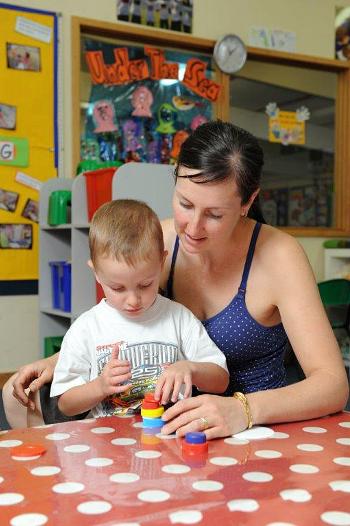Does it fit?
Duration/age

Children explore how things fit and connect together from a very young age. You might see this when your child tries to slot the car keys into different locks around the house or when they pull everything out of the cupboard and try and fit it back in.
There are many ways you can encourage your child to explore how different things connect and fit together using everyday objects. It can be as simple as figuring out how to put the DVD back inside its case. You could also try using a stack of differently sized plastic containers and encourage your child to work out how to stack them all inside the largest one.
Can you stack the measuring cups inside each other so we can put them away in the cupboard?
We need to pack your bag for childcare. We need to work out how to fit in your lunch box, spare clothes, your teddy and a drink bottle.
Materials you will need
- Plastic containers
- Saucepans, pots and pans
- Pots for pot plants
- Household objects
- Lock and keys
- Nuts and bolts
Alternative tools
- Puzzles
- Marble run games
- Stacking cups
Skills this activity improves
Why does this matter?
Encouraging your child to try and work out how things fit and work together helps them to develop persistence and problem-solving. Persistence and problem-solving are dispositions that are important for the development of numerical skills and understanding.
What does this lead to?
Experimenting with fitting things together and pulling them apart helps children to develop the language needed to describe their thinking. As you work with your child they will be developing the vocabulary to ask questions and describe the different positions and locations of the objects they are using.
Language to use
- Inside, outside, next to, on top of, against
- Turn, move, rotate, flip, direction
- Same, different, alternative, similar
- Possibility, option, solution, alternative
- Link, connect, join, slot, stack
- Measure
- Shape, size
- Top, bottom
Questions to use
- Can you turn it both ways?
- Can you put a big nut on a small bolt?
- Which one goes in first?
- Do you start to stack at the top or the bottom?
Useful tips
- You might also like to take a look at the activities Packing your bag and Packing the lunch box.
- Younger children are still developing hand strength and control. They can find it tricky to hold very small objects. Try using large objects that don't require as much finger strength.
- The local toy library has toys and puzzles that you can borrow.
- Remember to talk to your child in your home language.
More ideas
- Create a basket of found objects and bits and pieces. See if your child can work out where they go and how to put them back together.
- Ask your child to help you pack their lunch box.
- Make a pile of shoes. Ask your child to match the pairs and find the shoebox they fit in.
Variation by age
Birth to two year olds
- Borrow stacking toys from your local toy library.
- Borrow a train track from a toy library or a friend. Encourage your child to join the tracks together.
- Make a box with differently sized shapes and holes on the sides. Encourage your child to slot differently sized and shaped objects through the holes.
- Make your own puzzles using family photos.
Three to five year olds
- Borrow puzzles from your local toy library.
- Create a tinkering box. Include some keys and locks of different sizes, with some nuts and bolts, screws and screwdrivers.
- Create a play box with differently sized dolls and dolls’ clothing. Encourage your child to work out which clothing will fit which doll.
Questions to ask
- Does that fit?
- Can you turn it around?
- Which one is the same?
- Can you find one that looks like this?
Questions to ask
- Which one is bigger?
- Which piece do you need to do first?
- Do you need to start with the biggest piece or the smallest piece first?
- Do all screwdrivers fit all screws?
- Why do some screws have a cross or a star on the top and others have a straight line?
- Do dolls’ feet grow bigger?
Language to use
- Same, different
- Turn, move, rotate, next to
Language to use
- Small, smallest, big, bigger, biggest
- Same, different
- Star, cross, line
- First, second, next, last
- Before, after
- Turn, left, right, thread


